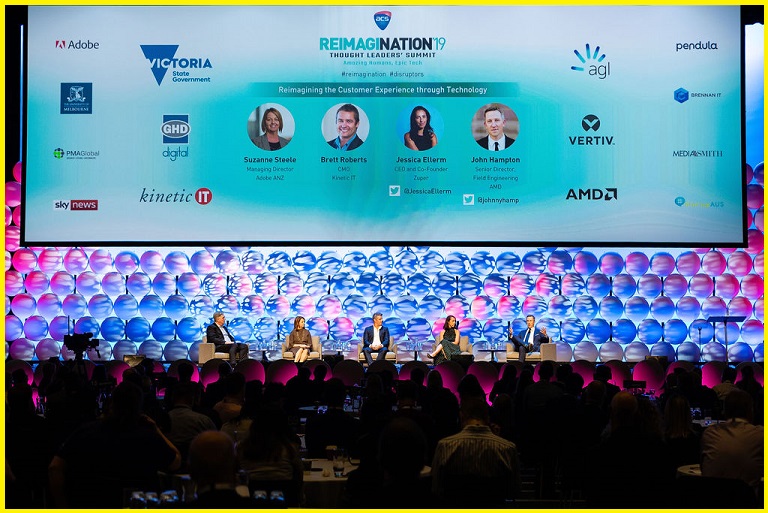Australia has the most demanding consumers in the world and local companies must deliver seamless experiences to satisfy them – but the “organised chaos” of product development lifecycles often hinders leadership from doing so, marketing and digital service development experts have warned.
The recent Adobe Experience Index found that consumers in Australia and New Zealand have the highest expectations from customer experience in the world, with 79 per cent demanding tailored experiences from organisations, and two-thirds quite happy to have interactions completely automated if done well.
For consumers, “having a great experience is about how you made them feel in that moment,” Adobe ANZ managing director Suzanne Steele said during a panel session at the recent ACS Reimagination 2019 conference.
“Organisations that deliver seamless personalised experiences drive massive customer loyalty, because in that moment you feel important to the brand – and organisations that get this right have much more engaged customers, and are much more profitable.”
Yet while younger Australians are the most patient demographic – just 38 per cent of 18-to-34 year olds said they would abandon their online shopping carts due to a bad experience, compared with 52 per cent of 35-pluses – companies must be careful not to take them for granted.
The younger generation “are a bit more forgiving,” Steele said, “however when they get to the point where their experience isn’t good enough, they are the segment that will go out and tweet about it.”

Breaking through organisational inertia
The importance of customer experience has not been lost on most business leaders, with Gartner noting that nearly half of companies can track the financial benefits of customer experience projects and more than 80 percent saying they expect to compete mainly based on their customer experience.
Yet while businesses conceptually understand the need to service customers well, the panellists pointed out, many struggle to innovate in the ways their customers want because they are too bound up with the strictures of existing products, services, and processes.
“In some cases you have this curse of knowledge,” said Jessica Ellerm, a former Tyro staffer who left to co-found superannuation start-up Zuper, of which she is now CEO.
“You know so much about a sector that you see barriers immediately and know so many things that could go wrong.”
Start-ups, she added, often find it easier to put customer experience at the forefront because “when you are more naïve you see opportunities and possibilities.”
Working across business disciplines in a small, fast-growing company had helped work across organisational boundaries and given her “a great opportunity to wear multiple different hats at a time,” Ellerm said.
“That helps you set a course to understand that true product lifecycle development phase from sales and marketing, to business development, working with engineering teams, to developing new products, and so on.”
Optimising the product lifecycle quickly becomes more complicated in the “organised chaos” of product development, Brett Roberts, chief marketing officer with managed-services firm Kinetic IT said.
“There are highly competitive buzzwords, lifecycles, and disruptive grenades flying everywhere – and that obscures the real innovations happening, particularly by private Australian companies.”
“Thought leadership gets a bit lost in that.”
A lifeline for a lifecycle
Such issues had been a constant challenge for a company like AMD, a world-leading designer and manufacturer of microprocessors that has had to work hard to focus its products on actual customer requirements rather than losing itself down a rabbit hole of engineering innovation.
“We had to recognise there were a lot of perspectives about what customers wanted and needed,” John Hampton, AMD senior director for field engineering told the Reimagination audience.
“That’s where we started collecting that feedback directly from customers and informing our engineering teams,” he explained.
Being first and fastest in the cut-throat microprocessor market are crucial – but given the long lead times around product development, he said, “we had to place some very big bets well in advance of the technology – and we decided to do thing differently by creating technology that is fundamentally different from the ground up.”
That drove a five-year process that involved “two million engineering hours” during which the company redefined the development process, Hampton explained.
Creating “parallel, leapfrogging design teams” and driving them along best practices “allowed us to accelerate our time to market, accelerating the development process in an innovative way.”
The company’s shares are trading at around 20 times what it was five years ago, Hampton said, noting that “and all of that comes back to listening to our audience and taking risks”.
Data and the new customer service
Yet better and more responsive customer service isn’t only about lighting a fire under too-entrenched internal tribes: data, the panellists agreed, had long ago become a key driver for reinventing the customer experience.
“It really starts and ends with the data,” Steele said, “and being able to glue the data together to really understand, across many silos, is the absolutely foundational layer for delivering personalised experiences.”
Yet while data is the driver for those experiences, Ellerm said, companies need to not just focus on the obscure things they can do with that data – but remember why they are using it.
“The big challenge for all organisations is how to deliver empathy for the customer,” she said, highlighting the importance of asking, “’How do I really understand how they are feeling in that moment where they are buying that product, rather than what they’re going to click next?’”
That’s why it was essential to leverage the right data to deliver customer experiences whose relevance makes them resonate with customers, she added.
“People can be quite forgiving if you deliver them something that makes them feel great.”










